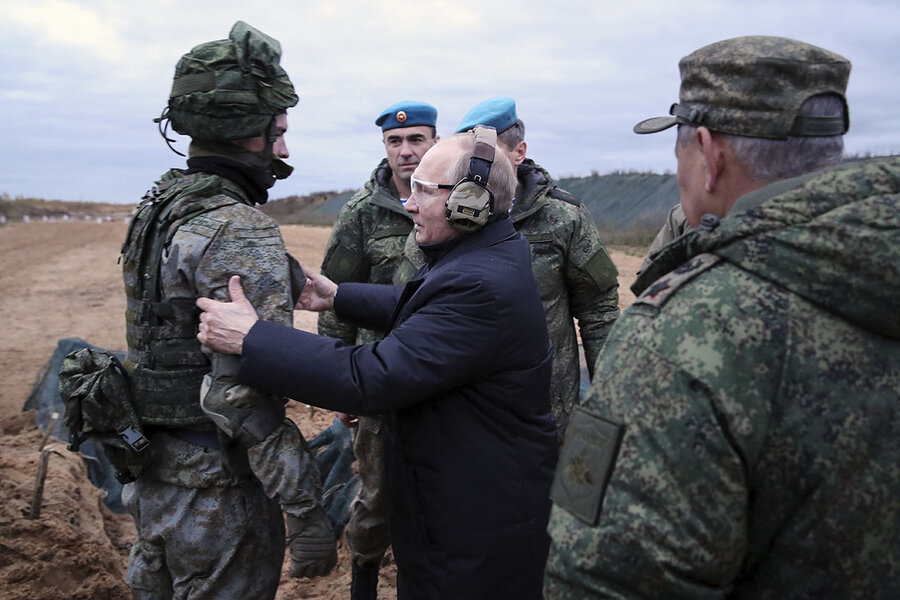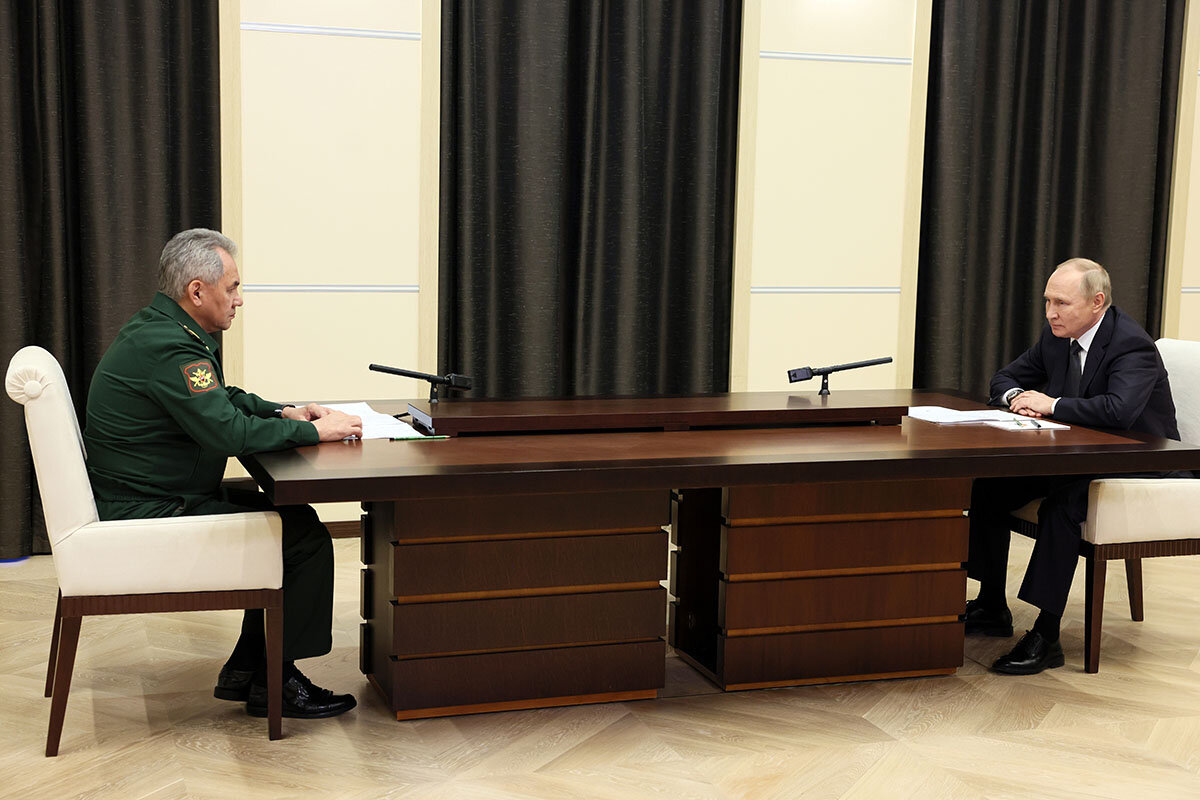The Kremlin got its 300,000 troops. But how did Russian society fare?
Loading...
| Moscow
Russian Defense Minister Sergei Shoigu announced Friday that the mass mobilization of 300,000 reservists has ended. But even supporters of the war in Ukraine admit that the effort has aroused deep anxieties among Russians.
An early October poll reported in the business daily Vedomosti found that 64% of Russians supported the mobilization, while 31% opposed it. But among young people, over half opposed it.
Why We Wrote This
A story focused onRussia’s chaotic mobilization of troops has ended, its goals largely met. But the public is still coming to grips with the psychological stresses of the process – and of the ongoing war in Ukraine.
Other sociological data suggests spiking levels of public fear, apprehension, and depression. A survey by the independent Levada Center found that the percentage of people in a “good mood” fell from 15% in July to 7% after the mobilization announcement, while those whose main feelings are “tension and irritation” leaped from 17% to 32% in the same period.
Yet while hundreds of thousands of military-aged men fled the country to avoid being drafted, many others have voluntarily turned up at recruitment centers. Sarah Lindemann-Komarova, an American who lives in Siberia, noted a sense of determination among the men boarding military buses at a late October send-off for local draftees in the Altai Republic, near Mongolia.
“I think there is both pride and duty that is there,” she says. “No one likes this war, but they believe in duty.”
Under Russia’s Constitution, men have the right to seek alternative service if their health or personal beliefs preclude being drafted into the army. Though this right is still almost entirely theoretical, for years, the Movement of Conscientious Objectors has been providing advice and legal assistance to help those who seek to exercise it.
Lately, it’s been very busy.
The self-described “refusenik” movement has been overwhelmed by appeals from men of many ages desperate to avoid the mass mobilization announced by President Vladimir Putin in September, and since then carried out by many regional governments with an indiscriminate zeal that even Mr. Putin has denounced as “stupidity.”
Why We Wrote This
A story focused onRussia’s chaotic mobilization of troops has ended, its goals largely met. But the public is still coming to grips with the psychological stresses of the process – and of the ongoing war in Ukraine.
“All the legal selection criteria have been ignored, and that’s a violation of federal law,” says Vadim, a spokesperson for the movement, who declined to give his family name. “We have reports of people being grabbed on the streets who have obvious health problems, of students being drafted even though they should be exempt, of manhunts in city transport with the help of police.”
Even supporters of the war in Ukraine, now in its ninth month, admit that the botched mobilization has radically altered social moods and aroused deep anxieties among a population that had previously been largely complacent about the conflict raging to the south.
But despite the well-documented reports about serious violations of law and procedure, the now-concluded wave of mobilization has probably achieved its main goals. Most of those drafted are men with past military experience who, officials insist, are being adequately equipped and given additional training. That will enable Russia to at least double its military forces in Ukraine by the end of the year.
“A lot of chaos”
Russian Defense Minister Sergei Shoigu announced Friday that the campaign has ended for now, having met its goal of mobilizing 300,000 reservists. He said that 82,000 of the new recruits are already in the combat zone, and the rest are undergoing training.
Though hundreds of thousands of military-aged men fled the country in recent weeks to avoid being drafted, many others have voluntarily turned up at recruitment centers and – with little visible enthusiasm, even in state TV reportage – accepted what is officially being presented as a patriotic call to duty. Even Vadim agrees that some of the bureaucratic excesses have been corrected, and many of those improperly conscripted were later released.
Though public acceptance of the war has been tested, and attitudes toward it are visibly changing, an initial wave of protests quickly petered out and has been replaced by what looks like widespread social resignation to the idea of more military escalation.
“I had many friends who left the country, and I myself had a lot of anxiety even though I’m not supposed to be drafted. Our president said that those who haven’t done military service shouldn’t be drafted,” says Nikita Lyakhovetskiy, a Moscow-area liberal activist who obtained a legal exemption from service on health grounds when he turned 18. “I understand how they feel, but they are losing their places in this country, their jobs, their studies.
“All my documents are in order, so perhaps I feel calmer than some people of my age. But I don’t believe you should run away, take rash decisions, and I haven’t. ... I have another friend who is doing his service voluntarily. He says he’s proud to defend his country and do his duty.”
Sergei Markov, a former Kremlin adviser and strong supporter of the war, agrees that there has been “a lot of chaos” in the course of the mobilization campaign. But, he argues, the hastily conceived call-up was based on a system that hadn’t been tested in over 40 years. It used often outdated and inaccurate lists of draftees, he says, and the sheer incoherence of the process led to a lot of unnecessary social turmoil.
“The government wasn’t prepared for this, and we knew there would be lots of mistakes,” he says. “Putin has ordered the creation of a digitized system, with accurate data, so these problems will not repeat in future mobilizations. Even the Russian media writes about all the people who were improperly served draft notices, but nobody mentions that most of the ineligible men were subsequently released after their cases were clarified. Complaints about training, and lack of the best equipment, are well grounded.
“On the other hand, a lot of old training centers were closed down after the end of the Soviet Union. They are derelict, and now they are being restored. I’ve been part of a group collecting equipment to donate to soldiers, because the army gives them only basic kit. If families want their men to have better things, they buy it for them. I am told that this is not uncommon in many armies,” Mr. Markov says.
“It’s true that at least 200,000 men left the country, including some relatives of mine,” he adds. “It seems that some people consider themselves to be citizens of the world, and not Russians first. But even Putin, when he was asked, refused to condemn them. We hope that some of them will return in time.”
Sarah Lindemann-Komarova, an American who has lived in Siberia for almost three decades, has described a late October send-off for local draftees in the remote Altai Republic, near Mongolia, where, by contrast, quite a few draft dodgers have taken refuge. She notes a grim mood, with distraught mothers, tears, and frightened faces, but also a sense of determination among the men boarding military buses.
“I think there is both pride and duty that is there,” she says. “No one likes this war, but they believe in duty.”
A souring of the public mood
There seems little doubt that Mr. Putin’s Sept. 21 announcement of the sudden and almost unprecedented mobilization of reserves triggered a tsunami of public angst. An early October poll reported in the business daily Vedomosti found that 64% of Russians supported the mobilization, while 31% opposed it. But among young people ages 18-26, over half opposed it.
Other sociological data suggests spiking levels of public fear, apprehension, and depression. A mid-October survey by the independent Levada Center found that the percentage of people who report being in a “good mood” fell from 15% in July to 7% after the mobilization announcement, while those whose main feelings are “tension and irritation” leaped from 17% to 32% in the same period. “There has never been such a sharp deterioration in public sentiment in the entire period of [our] observations,” the agency noted.
The state-funded Public Opinion Foundation reported an all-time peak of 70% in the share of Russians who say they feel “anxious,” in the weeks following the announcement. And Tass reported that in the first nine months of 2022, spending on antidepressants increased by 70% and sedatives by 56%.
A little-noticed aspect of this mobilization is the enormous increase in national security spending, by around half, in the upcoming Russian government budget. It’s not clear how all the new funds will be spent, but experts say they will probably be used to create new jobs to offset unemployment in other areas. Most of the men being called up in the current mobilization are to be paid at the significantly higher rate of contract soldiers, not that of regular conscripts. That will mean an average of around $3,000 monthly, or several times Russia’s median income.
Ukrainian sociologist Volodymyr Ishchenko argued in a commentary for Al Jazeera that Mr. Putin could be building a permanent war economy, one that redistributes wealth on a large scale – particularly as many of the mobilized men come from poorer regions – and creates its own constituency for more war.
“Looking at all these developments, we see something like military Keynesianism taking shape in Russia. Millions of Russians who are either mobilized to fight in Ukraine, employed in reconstruction or in the military industry, or participating in the suppression of unrest in the occupied territories and at home, or are family members, have turned into direct beneficiaries of the war,” he writes.
Mr. Lyakhovetskiy says the mobilization came as a shock, but people will probably get used to it.
“My generation was born after all the major crises, and we grew up feeling more European, more progressive,” he says. “No one expected this to happen. But in Russian history it seems that every generation has to go through something. So maybe this is our trial.”









